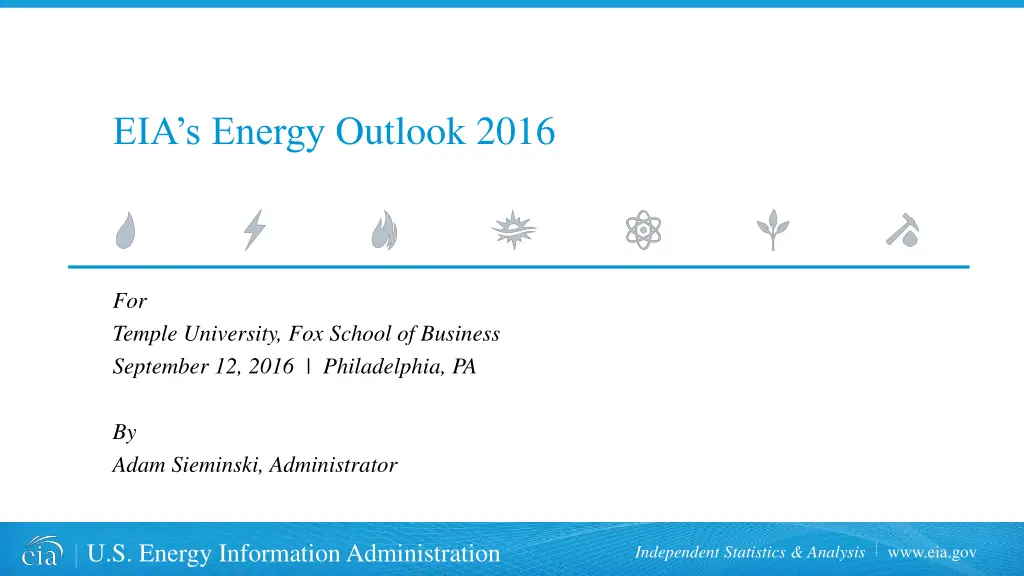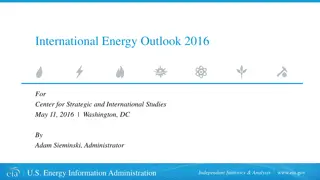
Energy Outlook 2016: Key Findings on Global Energy Consumption and Trends
Explore the key findings from the International Energy Outlook 2016, including the projected increase in world energy consumption, the growth of renewable energy sources, the shift in energy sources like natural gas and coal, and the implications on carbon dioxide emissions. Understand the evolving landscape of global energy production and consumption based on analysis by Adam Sieminski from Temple University.
Download Presentation

Please find below an Image/Link to download the presentation.
The content on the website is provided AS IS for your information and personal use only. It may not be sold, licensed, or shared on other websites without obtaining consent from the author. If you encounter any issues during the download, it is possible that the publisher has removed the file from their server.
You are allowed to download the files provided on this website for personal or commercial use, subject to the condition that they are used lawfully. All files are the property of their respective owners.
The content on the website is provided AS IS for your information and personal use only. It may not be sold, licensed, or shared on other websites without obtaining consent from the author.
E N D
Presentation Transcript
EIAs Energy Outlook 2016 For Temple University, Fox School of Business September 12, 2016 | Philadelphia, PA By Adam Sieminski, Administrator U.S. Energy Information Administration www.eia.gov Independent Statistics & Analysis
International Energy Outlook: key findings in the 2016 Reference case World energy consumption increases from 549 quadrillion Btu in 2012 to 629 quadrillion Btu in 2020 and then to 815 quadrillion Btu in 2040, a 48% increase (1.4%/year). Non-OECD Asia (including China and India) account for more than half of the increase. The industrial sector continues to account for the largest share of delivered energy consumption; the world industrial sector still consumes over half of global delivered energy in 2040. Renewable energy is the world s fastest-growing energy source, increasing by 2.6%/year; nuclear energy grows by 2.3%/year, from 4% of the global total in 2012 to 6% in 2040. Fossil fuels continue to supply more than three-fourths of world energy use in 2040. Adam Sieminski, Temple University September 12, 2016 2
International Energy Outlook: key findings in the 2016 Reference case (continued) Among the fossil fuels, natural gas grows the fastest. Coal use plateaus in the mid-term as China shifts from energy-intensive industries to services and worldwide policies to limit coal use intensify. By 2030, natural gas surpasses coal as the world s second largest energy source. In 2012, coal provided 40% of the world s total net electricity generation. By 2040, coal, natural gas, and renewable energy sources provide roughly equal shares (28-29%) of world generation. With current policies and regulations, worldwide energy-related carbon dioxide emissions rise from about 32 billion metric tons in 2012 to 36 billion metric tons in 2020 and then to 43 billion metric tons in 2040, a 34% increase. Adam Sieminski, Temple University September 12, 2016 3
Renewables grow fastest, coal use plateaus, natural gas surpasses coal by 2030, and oil maintains its leading share world energy consumption quadrillion Btu Source: EIA, International Energy Outlook 2016 and EIA, Analysis of the Impacts of the Clean Power Plan (May 2015) Adam Sieminski, Temple University September 12, 2016 4
Liquid fuels supplies from both OPEC and non-OPEC producers increase through 2040 world production of petroleum and other liquid fuels million barrels per day History Projections 2012 60 Non-OPEC crude and lease condensate 50 40 OPEC crude and lease condensate 30 20 Other liquids 10 0 2000 2010 2020 2030 2040 Source: EIA, International Energy Outlook 2016 Adam Sieminski, Temple University September 12, 2016 5
Renewables, natural gas, and coal all contribute roughly the same amount of global net electricity generation in 2040 world net electricity generation by source trillion kilowatthours 40 Nuclear 30 Other renewables Hydropower 20 Natural gas 10 Coal Liquids 0 2012 2020 2025 2030 2035 2040 Source: EIA, International Energy Outlook 2016 Adam Sieminski, Temple University September 12, 2016 6
Of the worlds three largest coal consumers, only India is projected to continue to increase throughout the projection coal consumption in the US, China, and India quadrillion Btu Source: EIA, International Energy Outlook 2016 and EIA, Analysis of the Impacts of the Clean Power Plan (May 2015) Adam Sieminski, Temple University September 12, 2016 7
U.S. Energy Outlook: key takeaways from AEO2016 Energy use per dollar of Gross Domestic Product declines through 2040 allowing for economic growth without upward pressure on energy consumption and related emissions. Electricity demand growth slows while non-power sector generation increases, dampening the need for central power station generation. Market forces drive up oil prices throughout the projection and U.S. production increases in response. Natural gas production increases despite relatively low and stable natural gas prices. Technological improvements are key drivers of U.S. oil and gas production. Adam Sieminski, Temple University September 12, 2016 8
U.S. Energy Outlook: key takeaways from AEO2016 (continued) Net exports of liquefied natural gas range between 3.5 Tcf and 10.6 Tcf in 2040 depending on relative prices in foreign markets. EPA s proposed medium and heavy-duty vehicle Phase 2 standards would increase fuel economy, resulting in 18% lower diesel consumption in 2040 compared with the Reference case. EPA s Clean Power Plan (CPP) requires states to reduce carbon dioxide emissions from existing fossil generators: Details of the CPP implementation strategies selected by the states affect the overall generation mix, as well as consumer prices CPP effects on coal production vary across regions Adam Sieminski, Temple University September 12, 2016 9
U.S. Energy Outlook: key takeaways from AEO2016 (continued) CPP, along with renewable tax credit extension and lower natural gas prices, contributes to a shift in the generation mix, with increases in generation from natural gas and renewables and reduced coal generation Even if the CPP is not implemented, key factors combine to support a transition from coal to natural gas as the predominant fuel for electric generation Extending or expanding existing laws and regulations, including efficiency policies for appliances and vehicles, the CPP, and EPA s proposed Phase 2 standards for medium- and heavy-duty trucks results lower energy consumption and CO2 emissions than projected in the Reference case. Adam Sieminski, Temple University September 12, 2016 10
Reductions in energy intensity largely offset impact of gross domestic product (GDP) growth, leading to slow projected growth in energy use U.S. primary energy consumption quadrillion Btu 2015AEO2016 Reference Projections No CPP Projections 2015 120 History 100 32% of U.S. total 33% Natural gas 29% 80 12% (excluding biofuels) 14% 8% Renewables 60 36% 33% Petroleum and other liquids 34% 40 Liquid biofuels 1% 1% 1% 9% Nuclear 20 8% 14% 8% 10% Coal 16 0 1980 1990 2000 2010 2020 2030 2040 2020 2030 2040 Source: EIA, Annual Energy Outlook 2016 Adam Sieminski, Temple University September 12, 2016 11
U.S. crude oil production rises above previous historical high before 2030; alternative price and resource/technology cases can differ U.S. crude oil production million barrels per day High Oil and Gas Resource and Technology Projections Reference 2015 2015 2015 20 Projections Projections History High Oil and Gas Resource and Technology 15 U.S. maximum production level of 9.6 million barrels per day in 1970 High Oil Price 10 Reference Tight oil Low Oil Price 5 Low Oil and Gas Resource and Technology Lower 48 offshore Other lower 48 onshore Alaska 0 1990 2000 2010 2020 2030 2040 2020 2030 2040 2020 2030 2040 Source: EIA, Annual Energy Outlook 2016 Adam Sieminski, Temple University September 12, 2016 12
U.S. natural gas production dominated by shale resources; alternative price and resource /technology assumptions could be quite different U.S. dry natural gas production trillion cubic feet U.S. dry natural gas production trillion cubic feet billion cubic feet per day History Projections Projections 2015 60 60 160 High Oil and Gas Resource and Technology 140 50 50 High Oil Price 120 2016 Reference 40 40 100 Low Oil Price 2015 Reference 30 30 80 Shale gas and tight oil plays 60 Low Oil and Gas Resource and Technology 20 20 40 Other lower 48 onshore 10 10 Tight gas Alaska 20 Coalbed methane Alaska Lower 48 offshore 0 0 0 1990 2000 2010 2020 2030 2040 2015 2020 2025 2030 2035 2040 Source: EIA, Annual Energy Outlook 2016 Adam Sieminski, Temple University September 12, 2016 13
Both natural gas and renewable generation surpass coal by 2030 in the Reference case, but only natural gas does so in the No CPP case net electricity generation billion kilowatthours AEO2016 Reference Projections No CPP Projections 2015 2015 2,500 History 2,000 Coal 1,500 Natural gas 1,000 Nuclear 500 Renewables Petroleum 0 1990 2000 2010 2020 2030 2040 2020 2030 2040 Source: EIA, Annual Energy Outlook 2016 Adam Sieminski, Temple University September 12, 2016 14
U.S. net energy imports trend downward, reflecting increased oil and natural gas production coupled with slowly growing or falling demand U.S. net imports quadrillion Btu History Projections 2015 30 Liquids 20 10 Natural gas 0 Coal -10 1970 1975 1980 1985 1990 1995 2000 2005 2010 2015 2020 2025 2030 2035 2040 Source: EIA, Annual Energy Outlook 2016 Adam Sieminski, Temple University September 12, 2016 15
For more information U.S. Energy Information Administration home page | www.eia.gov Annual Energy Outlook | www.eia.gov/aeo Short-Term Energy Outlook | www.eia.gov/steo International Energy Outlook | www.eia.gov/ieo Monthly Energy Review | www.eia.gov/mer Today in Energy | www.eia.gov/todayinenergy State Energy Profiles | www.eia.gov/state Drilling Productivity Report | www.eia.gov/petroleum/drilling/ International Energy Portal | www.eia.gov/beta/international/?src=home-b1 Adam Sieminski, Temple University September 12, 2016 16


